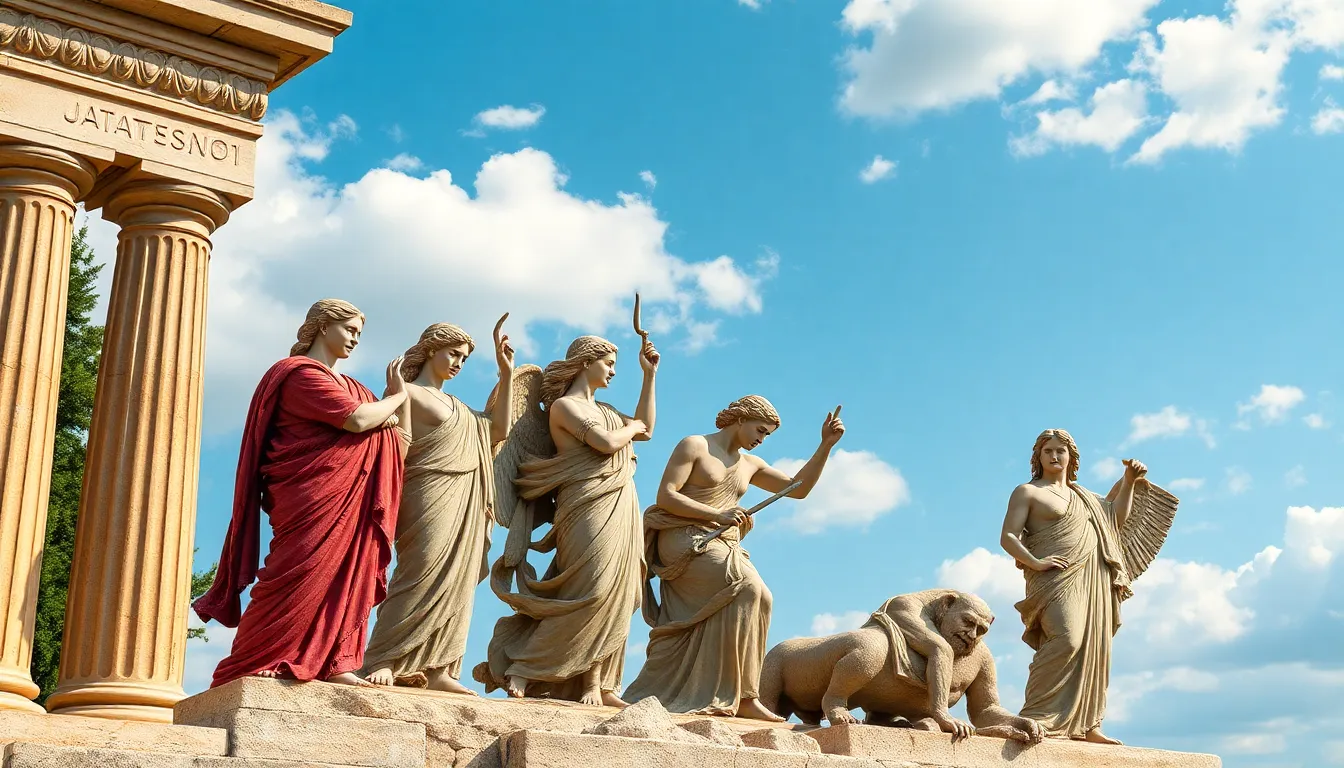The Muses in the Context of Ancient Greek Education
I. Introduction
The Muses, the nine goddesses of the arts and sciences in Ancient Greek culture, represent a significant aspect of the educational framework that formed the foundation of Greek society. Each Muse presides over a different domain of knowledge and creativity, inspiring individuals to pursue excellence in various fields. Their importance in the educational processes of Ancient Greece cannot be overstated, as they were seen as divine sources of inspiration for scholars, poets, and artists alike. This article aims to explore the role of the Muses in Ancient Greek education, their influence on literature and philosophy, and their lasting legacy in modern educational practices.
II. The Muses: A Brief Overview
The Muses are often depicted as beautiful young women, each associated with a specific area of the arts and sciences. The nine Muses are:
- Calliope – Muse of epic poetry
- Clio – Muse of history
- Erato – Muse of lyric poetry
- Euterpe – Muse of music
- Melpomene – Muse of tragedy
- Polyhymnia – Muse of sacred poetry and hymns
- Terpsichore – Muse of dance
- Thalia – Muse of comedy
- Urania – Muse of astronomy
Historically, the Muses have their origins in the oral traditions of the Greeks, serving as embodiments of the creative spirit. Their mythological significance extends beyond mere representation; they are seen as the personifications of knowledge and inspiration, guiding humanity toward enlightenment and artistic expression.
III. The Role of the Muses in Ancient Greek Education
The Muses played an integral role in the traditional education systems of Ancient Greece. They were often invoked in educational settings to provide inspiration and motivation for learners. The integration of the Muses in education can be summarized in the following ways:
- Source of Motivation: The Muses were seen as divine patrons who inspired students to engage deeply with their studies.
- Influence on the Arts and Sciences: The study of arts and sciences was often intertwined with the reverence for the Muses, encouraging a holistic educational approach.
By invoking the Muses, educators hoped to encourage creativity and critical thinking among students, fostering a culture of inquiry and artistic exploration.
IV. The Muses in Literature and Philosophy
In classical literature, the Muses are frequently depicted as sources of inspiration for poets and philosophers. Notable works by authors such as Homer and Hesiod illustrate their importance:
- Homer: In the “Iliad” and “Odyssey,” Homer calls upon the Muses to provide him with the knowledge and inspiration needed to convey his epic tales.
- Hesiod: In “Theogony,” Hesiod describes how the Muses inspired him to write about the origins of the gods and the cosmos.
Philosophers like Plato and Aristotle also acknowledged the Muses in their works, interpreting them as essential figures that bridge the gap between knowledge and artistic expression. The Muses symbolized the pursuit of wisdom and beauty, emphasizing the interconnectedness of knowledge and creativity.
V. The Muses and the Cultivation of Rhetoric
Rhetoric was a vital component of Ancient Greek education, regarded as the art of persuasive speech and argumentation. The Muses had a significant impact on the teaching of rhetoric, as they were believed to inspire eloquence and clarity in communication. Key aspects include:
- Significance of Rhetoric: Rhetoric was essential for public discourse, legal matters, and political life in Ancient Greece.
- Teaching Persuasive Speech: Educators would invoke the Muses to inspire students to master the art of persuasion.
- Case Studies: Renowned orators such as Demosthenes and Cicero often paid homage to the Muses in their speeches, acknowledging their influence on their rhetorical abilities.
This reverence for the Muses in rhetoric highlights their central role in shaping effective communication and debate within Ancient Greek society.
VI. The Muses in Music and Performance Arts
The Muses were also pivotal in the development of music education and performance arts in Ancient Greece. Their influence is evident in several areas:
- Music Education: The Muses inspired the creation and teaching of music, emphasizing its importance in education and culture.
- Theatrical Arts: The Muses were honored in theatrical performances, which often included elements of drama, comedy, and music.
- Festivals and Competitions: Festivals such as the Dionysia celebrated the Muses, showcasing competitions in poetry, music, and drama.
Their presence in these areas underscored the significance of the performing arts as a vital component of education and cultural expression in Ancient Greece.
VII. The Legacy of the Muses in Modern Education
The enduring legacy of the Muses continues to influence contemporary education. Key aspects of their relevance today include:
- Continued Relevance: The Muses remain a symbol of creativity and inspiration, encouraging modern educators to foster these qualities in students.
- Resurgence of the Liberal Arts: The revival of interest in the liberal arts and humanities reflects the Muses’ influence in promoting a well-rounded education.
- Lessons for Today: Ancient Greek educational practices, emphasizing creativity and critical thinking, offer valuable lessons for today’s learning environments.
As educators strive to inspire the next generation, the Muses’ legacy serves as a reminder of the importance of nurturing creativity and exploration in all fields of study.
VIII. Conclusion
In summary, the Muses played a crucial role in Ancient Greek education, influencing literature, philosophy, rhetoric, music, and the arts. Their impact on education and culture is profound, fostering creativity and inspiration that continue to resonate today. As we reflect on the enduring influence of the Muses, it becomes clear that fostering creativity and inspiration in modern education is essential. By embracing the legacy of the Muses, we can cultivate a richer, more vibrant educational landscape that honors the pursuit of knowledge and artistic expression.




